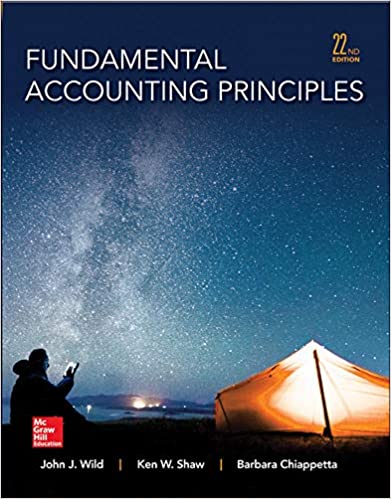
Fundamental Accounting Principles 22th Edition by John Wild ,Ken Shaw,Barbara Chiappetta
Edition 22ISBN: 978-0077862275
Fundamental Accounting Principles 22th Edition by John Wild ,Ken Shaw,Barbara Chiappetta
Edition 22ISBN: 978-0077862275 Exercise 31
Refer to Apple 's financial statements in Appendix A to answer the following.
1. For both fiscal years ended September 28, 2013, and September 29, 2012, identify the total amount of cash and cash equivalents. Determine the percent (rounded to one decimal) that this amount represents of total current assets, total current liabilities, total shareholders' equity, and total assets for both years. Comment on any trends.
2. For fiscal years ended September 28, 2013, and September 29, 2012, use the information in the statement of cash flows to determine the percent change (rounded to one decimal) between the beginning and ending year amounts of cash and cash equivalents.
3. Compute the days' sales uncollected (rounded to two decimals) as of September 28, 2013, and September 29, 2012. Has the collection of receivables improved Are accounts receivable an important asset for Apple Explain.
Fast Forward
4. Access Apple's financial statements for fiscal years ending after September 28, 2013, from its website ( Apple.com ) or the SEC's EDGAR database ( www.SEC.gov ). Recompute its days' sales uncollected for years ending after September 28, 2013. Compare this to the days' sales uncollected for fiscal years ended September 28, 2013, and September 29, 2012.
Reference : Apple 's financial statements in Appendix A




1. For both fiscal years ended September 28, 2013, and September 29, 2012, identify the total amount of cash and cash equivalents. Determine the percent (rounded to one decimal) that this amount represents of total current assets, total current liabilities, total shareholders' equity, and total assets for both years. Comment on any trends.
2. For fiscal years ended September 28, 2013, and September 29, 2012, use the information in the statement of cash flows to determine the percent change (rounded to one decimal) between the beginning and ending year amounts of cash and cash equivalents.
3. Compute the days' sales uncollected (rounded to two decimals) as of September 28, 2013, and September 29, 2012. Has the collection of receivables improved Are accounts receivable an important asset for Apple Explain.
Fast Forward
4. Access Apple's financial statements for fiscal years ending after September 28, 2013, from its website ( Apple.com ) or the SEC's EDGAR database ( www.SEC.gov ). Recompute its days' sales uncollected for years ending after September 28, 2013. Compare this to the days' sales uncollected for fiscal years ended September 28, 2013, and September 29, 2012.
Reference : Apple 's financial statements in Appendix A




Explanation
1.
Cash and cash equivalents involves co...
Fundamental Accounting Principles 22th Edition by John Wild ,Ken Shaw,Barbara Chiappetta
Why don’t you like this exercise?
Other Minimum 8 character and maximum 255 character
Character 255


